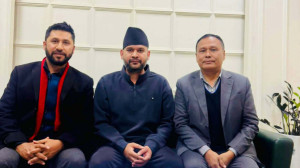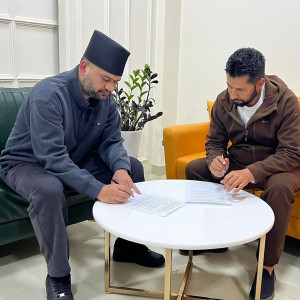Politics
As Nepali Congress eyes majority, Maoist Centre wants to be kingmaker
A tug of war starts in the ruling coalition, with partners working to go to polls together but also attempting to limit each other.
Tika R Pradhan
Now that the elections have been announced following an agreement among the five parties in the ruling coalition, things have boiled down to something that’s going to be a major headache for them—seat-sharing.
While the Nepali Congress, the coalition leader, is aiming to win a majority, its at least three partners—the CPN (Maoist Centre), the CPN (Unified Socialist), and the Janata Samajbadi—are in a bid to wrest as many seats as possible.
Observers and insiders say while the coalition partners want to go to polls under an understanding so as to keep the CPN-UML in check, there is a tug of war ongoing between the Congress and the group of three other parties [parties other than the Rastriya Janamorcha] to limit each other.
During a Congress meeting on Monday, leaders suggested that there should be division of seats on a 60:40 ratio, which means keeping 100 seats, out of 165 under the first-past-the-post system, for the Congress and leaving the remaining 65 for the rest of the partners.
The Congress strategy, according to party insiders, is to win seats close to a majority, if not a majority, with the help of the coalition partners.
“It’s natural for the parties to make attempts to secure even an additional seat,” said Pradip Poudel, a central executive committee member of the Congress.
As the Congress’ coalition partners are demanding more seats for them—at least 80 or so—which will reduce the share of Congress to 85 seats, making it difficult to achieve a majority or to get close to a majority.
Observers say the Congress believes it will manage to win 40 seats under the proportional representation category, same as last elections in 2017, and is trying to increase the number this time hoping to benefit from the split in the UML.
If the Congress manages to win 45 seats under the PR category and around 80 under the FPTP, it does not have to depend on the Maoist Centre, which hopes to emerge as a kingmaker, to form a government.
The Congress was reduced to 23 seats under the FPTP system in the last elections, largely due to an alliance between the UML and the Maoist Centre. With the Unified Socialist, the UML’s breakaway party, currently in the coalition, the Congress is seeing better prospects for itself.
The Congress’ coalition partners, however, are in a bid to steal as many seats as they can under the FPTP system so as to increase their prospects, since they are largely dependent on the Congress votes to win. Meanwhile, the Congress seems to be working in such a way that even if it does not get a majority, there should not be a situation for the UML and the Maoist Centre to join hands to form a government.
Maoist leaders have already objected to the Congress’ plan to keep 100 seats for itself.
“The coalition partners won’t accept the Congress’ proposal. What the Congress is saying is just a bargaining tactic. It won’t stick to its 60 percent demand,” said Hemraj Bhandari, a politburo member of the Maoist Centre. “What will the other parties do if the Congress keeps 99 seats for itself?”
To maintain pressure on the Congress, some Maoist Centre leaders including Barshaman Pun have been saying that the prospect of forging an electoral alliance has not ended yet, despite reaching an agreement in the coalition to go to the polls together.
Unified Socialist chair Madhav Nepal has also been saying that his party would field candidates in all constituencies if the coalition partners attempted to undermine the party.
On Tuesday, senior Unified Socialist leader Jhala Nath Khanal met with Prime Minister Deuba and conveyed to the latter that seat-sharing should not be done in a way that undermines any party.
According to sources, Khanal called on Deuba for respectful seat-sharing among the partners.
Meanwhile, the task force formed by the ruling coalition has started its work with the aim to submit a report on seat-sharing by August 16. On Monday, the task force appointed Krishna Prasad Sitaula of the Congress as its coordinator.
To ensure that the Congress gets the seats it wants, the party has floated the number of possible FPTP seats by calculating the votes the parties in the ruling coalition garnered at the ward level in May 13 local polls.
According to a report prepared by Congress leaders, the party will win 77 seats, UML 70, Maoist Centre 8, Janata Samajbadi 4, Loktantrik Samajbadi Nepal 2 seats and Unified Socialist 1 if the parties fight the elections individually.
Political commentator Jhalak Subedi said for the Maoist Centre, their votes in the proportional representation system will bar them from securing the second position even if they get more seats than the UML under the FPTP system.
“The Maoist Centre is aiming to become a party without which a new government cannot be formed so as to lay claim to the prime minister’s post,” Subedi told the Post. “They want to keep the Congress in check and cut the UML down to size.”
But, according to Subedi, there is a conflict within the Congress about whom to make the prime minister after the polls as Deuba could project his spouse Arzoo Deuba while the Shekhar Koirala-led faction could project Gagan Thapa, a party general secretary.
“Both the factions within Congress, however, are one on two issues—garnering a majority from the upcoming polls and blocking the Maoist Centre from going to the UML’s fold,” said Subedi.
The task force has decided to hold the next meeting on Thursday.
“We need to discuss some issues within the parties first,” said Ananda Sharma, a member of the task force representing the Rastriya Janamorcha.




 6°C Kathmandu
6°C Kathmandu














